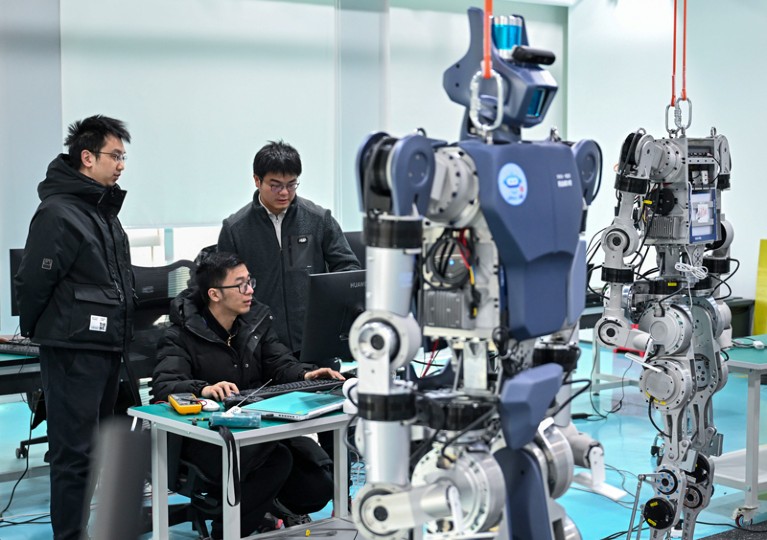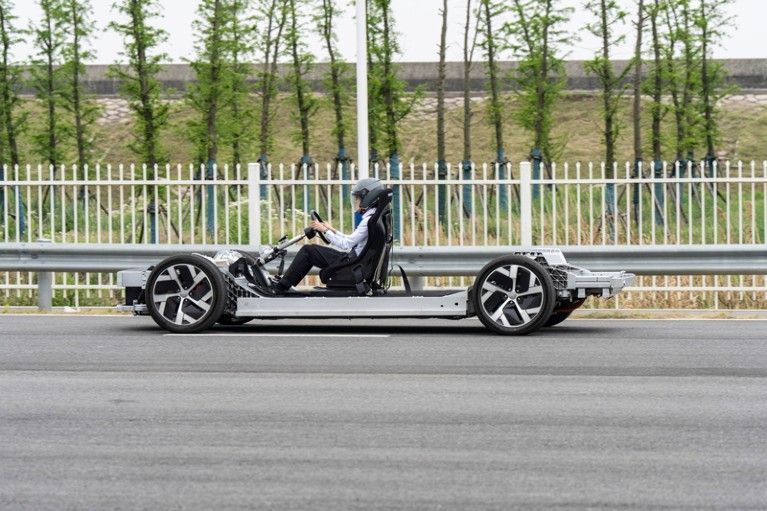In the past two decades, China has made big advances in scientific research, and its rise to the top of the 2025 Nature Index tables highlights this shift (see go.nature.com/45vf99n). According to these metrics, which track and fairly compare each country’s contributions to research articles in top journals, China has surpassed the United States in producing high-quality natural-sciences research (see ‘High-impact research’).
Even so, Chinese research faces big challenges. For example, the country still struggles to deliver groundbreaking discoveries and convert its research into commercial successes. The commercialization rate of Chinese university patents has remained below 5%. In the United States, the average annual patent transfer ratio is greater than 54%1. Several Chinese companies also continue to rely on imported technologies, particularly from the United States.
This innovation bottleneck is compounded by global trends: the COVID-19 pandemic, rising protectionism in trade and escalating US–China technological tensions, which have disrupted international cooperation and deepened the need for domestic technological independence. As global dynamics shift and the push to ‘decouple’ the United States from China intensifies2, the country now faces the urgent task of building greater scientific self-reliance.

China can build on advances it has made since 2022, when it shifted its science policy towards an ‘organized research’ model — emphasizing mission-driven science, nationwide resource mobilization and cross-institutional collaboration. By forming task-focused teams and tackling urgent challenges at the frontiers of science and economic needs, the policy seeks to drive scientific breakthroughs in areas that are crucial to the country’s strategic priorities, such as artificial intelligence (AI), renewable energy, biomedicine and fundamental science.
Here, we outline the shifts in policy, explore the challenges and suggest ways to find a balance between pursuing collective national goals and fostering individual scientific creativity.
Big science era
Modern science is deeply influenced by social, political and institutional factors. Changes under way in China include the following.
How science is organized. In 2023, China established the Central Science and Technology Commission to reinforce the Communist Party’s leadership over the country’s scientific and technological agenda. The commission is tasked with coordinating the development of ‘strategic science’ — research aligned with national priorities and long-term goals.
At the national level, more than 300 state key laboratories (SKLs) — the country’s top research centres — have been restructured since 2022 to promote cross-institutional collaboration. For example, the SKL for Photovoltaic Science and Technology was restructured around a partnership between photovoltaics company Trina Solar in Changzhou and Fudan University in Shanghai. This collaboration aims to harness the complementary strengths of academia and industry to drive innovation in solar technology.
At the institutional level, universities are building new research platforms. For example, last year, China Pharmaceutical University in Nanjing launched its Intelligent Pharmacy Institute, bringing together AI and drug discovery under a unified, centralized framework. By consolidating funding, personnel and interdisciplinary expertise, the institute seeks to streamline AI-driven pharmaceutical research. It also collaborates closely with leading pharmaceutical companies through initiatives such as the Intelligent Pharmacy Education–Industry Alliance to address real-world industrial challenges.
How resources are mobilized. Big science projects, which need massive resources, go beyond the capacity of a single institution or small research team. In 2024, to better channel resources and align research with pressing national priorities, China shifted the responsibility for key research and development programmes from the Ministry of Science and Technology to sector-specific government agencies, such as the Ministry of Water Resources. To boost China’s participation in international big-science initiatives, the latest key project for Intergovernmental International Cooperation on Science and Technology Innovation was launched in May. It aims to fund around 169 collaborative projects with a total budget of approximately 304 million yuan (US$42.4 million).

Robotics is one of the Communist Party of China’s priority areas for research, along with artificial intelligence and biomedicine.Credit: Du Zixuan/Xinhua/eyevine
By contrast, individual researchers are facing tighter competition and fewer resources. The General Programs of the National Natural Science Foundation of China (NSFC) — a major funding source for individual scientists — saw average grant sizes decline by 8.1% between 2022 and 2024, while applications surged by 53%, signalling increasingly limited funding opportunities for independent research3,4.
How scientists are evaluated. Appraisal and evaluation systems are being reshaped. Technology transfer and real-world impact are gaining more influence in how science and scientists are assessed. For instance, the updated Interim Measures for the Administration of the National Key R&D Program, issued last year, places greater emphasis on research outcomes than it does on academic publications, with a particular focus on how breakthroughs can translate into practical applications.
Researchers in China are now encouraged to embody the ideal of Ding Tian Li Di scientists. Ding Tian — ‘reaching the sky’ — represents the pursuit of cutting-edge research, and Li Di — ‘standing on the ground’ — emphasizes serving national priorities and delivering tangible societal impact. This slogan encapsulates China’s broader shift in research evaluation: scientists are expected to excel not only in academic prestige but also in addressing real-world challenges and contributing to national competitiveness.
Emerging concerns
Although success will surely follow, we identify three challenges faced by the organized-research policy that might prevent China from achieving all its desired goals.
First, Chinese universities remain organized mainly around conventional academic disciplines, with government resources allocated to specific departments. However, this structure is often ill-suited to addressing complex national priorities — such as achieving carbon neutrality — that demand coordinated efforts across disciplines, such as energy systems, chemistry, environmental science and management.
In response, research units and interdisciplinary platforms have begun to emerge. Yet, these often remain entangled with existing discipline-based structures. For example, the Institute of Carbon Neutrality at Peking University in Beijing, established in 2023, significantly overlaps with conventional departments: 113 of its researchers hold dual appointments with their original academic institutions. This dual affiliation creates competition for faculty members’ time and research funding, limiting the institute’s ability to function as an independent driver of interdisciplinary research.
Furthermore, structural barriers persist. Faculty members must still declare a disciplinary affiliation when applying for grants and promotions, and their work is typically evaluated by their peers from the same field. As a result, there is little institutional incentive to engage in cross-disciplinary or cross-unit collaboration.
Second, the way in which the Chinese government is organizing research and allocating resources might draw scientists into a narrow set of fields, which could discourage grassroots innovation and limit academic freedom. One indicator of this is the shrinking share of General Programs in the NSFC budget — these programmes, known for their broad scope and investigator-driven nature, accounted for only 31.5% of total funding in 2023, down from 51.0% in 2013. This trend suggests growing challenges for researchers seeking support for self-directed, curiosity-driven research.

Chinese universities rely on strategic collaborations with industry to expand battery research.Credit: Qilai Shen/Bloomberg/Getty
Although the mission-oriented model can mobilize national capacity for targeted goals, it risks producing scientific uniformity and undermining small-scale research efforts, which some studies suggest are more productive5 and more likely to yield original or disruptive discoveries6.
Another risk lies in the volatility of government priorities. When state support is withdrawn, entire research areas can stagnate. A historical example is the termination of the US Superconducting Super Collider (SSC) project in 1993 owing to budget overruns, management challenges and waning political support. The SSC had aimed to discover the Higgs boson — an achievement ultimately realized by the Large Hadron Collider at CERN, Europe’s particle-physics laboratory near Geneva, Switzerland, in 2012. The SSC’s cancellation serves as a cautionary tale of how shifts in political will can derail long-term scientific efforts, regardless of their potential.
Third, large-team, heavily funded ‘big science’ tends to concentrate decision-making and resources to a small group of leading scientists. Marginalized or less established researchers might have limited opportunities to contribute meaningfully to big projects. And even if they do participate, problems might arise with sharing awards, honours and resources equitably.
A path forward
Here, we propose a few suggestions to mitigate these challenges.


